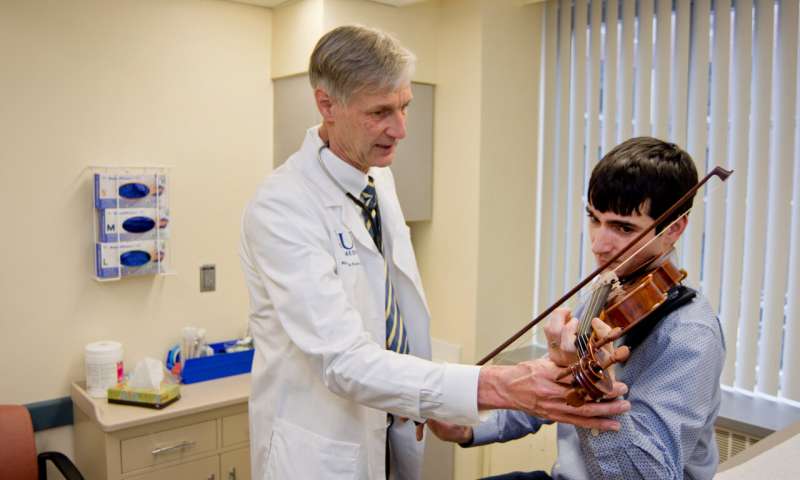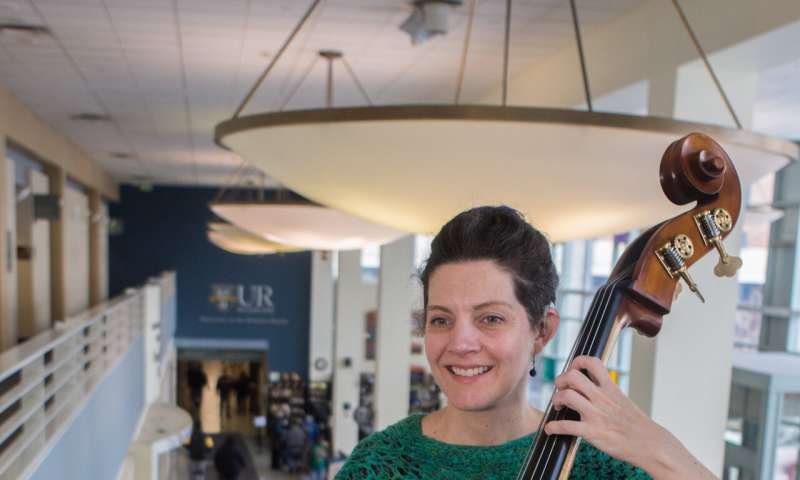Medicine and music: Eastman School of Music, Univ. of Rochester Medical Center join forces

The Eastman School of Music and University of Rochester Medical Center (URMC) have unveiled a collaboration that's laying a foundation for clinicians, artists and researchers to innovate connections between health and the arts.
The new initiative, Eastman Performing Arts Medicine (EPAM), unifies and expands existing clinical services, arts integration and research to transform arts-related health care delivery and scientific understanding of the interactions between the arts and health.
"We are pleased to partner with the Eastman School of Music to launch the Eastman Performing Arts Medicine initiative," said Mark Taubman, M.D., who is CEO of URMC and dean of the School of Medicine and Dentistry. "This program is close to my heart. It blends my personal passions for medicine and the performing arts into a program that benefits musicians and general patients alike."
EPAM synthesizes the resources and artistic expertise of a world-renowned music school with the cutting-edge treatments and scientific research of a top-tier academic medical center. The program's structure comprises four branches: clinical services for artists, creative arts therapy for hospital patients, scientific research and performances in clinical spaces.
"Eastman Performing Arts Medicine is a model of the kind of collaboration that takes place across disciplines throughout the university," said Jamal Rossi, who is the Joan and Martin Messinger Dean of the Eastman School of Music.
To develop the first program of its kind in upstate New York, EPAM leaders consulted with national experts in performing arts medicine, including J. Todd Frazier, president of the National Organization for Arts in Health.
"One of the prerequisites for a successful arts-in-health program is a first-class arts and medical community," said Frazier, who also directs the Houston Methodist Center for Performing Arts Medicine. "Rochester, through the Eastman School of Music and the University of Rochester Medical Center, has that solidly in place. EPAM has built a two-way bridge between the institutions to foster innovative collaborations in caring, caregiving, learning and research."
Urgent care for artists
For performing artists, time lost to injury or illness presents financial, physical and emotional challenges. EPAM's clinicians are dedicated to helping artists return to the stage as soon as possible. To streamline access to clinical care, EPAM has launched a new hotline to connect performers with health care specialists within 48 hours.
"We're well aware that the show must go on," said Ralph Manchester, M.D., who is vice provost and director of University Health Service as well as president of the Performing Arts Medicine Association. "Performing artists who are dealing with a problem that's interfering with their ability to perform deserve the same level of medical expertise that injured athletes receive."
EPAM specialists work closely with performers to develop treatment plans balancing the need for a quick return to performance schedules with the realities of tissue healing and a safe resumption of a productive practice schedule, said Manchester, who has researched performing arts medicine for. EPAM clinicians treat a range of conditions impacting performance, including chronic overuse injuries like carpal tunnel syndrome, tendonitis and vocal fold nodules, as well as acute illnesses or sudden injuries.

Performers of artistic disciplines beyond music, including dance and theater, can benefit from the program's highly specialized providers.
Healing through the arts
EPAM's clinical operations aren't limited to treating performers. One of the program's goals is to increase music and creative arts therapy services for patients—performers or otherwise.
Delivered by credentialed health professionals, music and creative arts therapy encompass a variety of clinical, evidence-based interventions that address patients' physical, emotional, cognitive and social needs. Pediatric patients have received music therapy services at URMC for over 20 years, but EPAM aims to increase creative arts therapy at Golisano Children's Hospital and to extend services to URMC's adult patients.
"There is strong evidence supporting the clinical benefits of music and other creative arts therapies," said Michael Rotondo, M.D., F.A.C.S., who is CEO of the University of Rochester Medical Faculty Group. "We look forward to expanding music and creative arts therapy resources for both pediatric and adult patients."
Research has demonstrated that arts therapy interventions offer benefits including reduced risk of hospital readmission, improved blood pressure and respiratory function, pain reduction and an enhanced quality of life, Rotondo added.
Music in medical spaces
For many patients and their loved ones, time spent in hospitals is high-stress. Recognizing the value of integrating arts into the hospital experience, EPAM hosts regular solo and ensemble performances by Eastman faculty, students and alumni.
"When performing in a traditional concert setting, there's often very little exchange between the performer and listener, and it can feel a little impersonal at times," said oboist Max Adler, a recent Eastman graduate and EPAM performer. "In a hospital setting, you're given the chance to see directly how your music is benefiting those who need support."
Current EPAM venues include the lobbies and entrances to Strong Memorial Hospital, Wilmot Cancer Institute and Flaum Atrium. EPAM aims to add performance opportunities throughout URMC and its affiliates and has piloted performances in the department of psychiatry, with plans to bring musicians to Highland Hospital soon.
"One of George Eastman's goals in founding the Eastman School of Music was a commitment to the enrichment of community life," said Rossi.
"Eastman is proud to partner with UR Medicine to create a program that infuses the medical center with music, offers specialized clinical care of the highest order to musicians and other artists, uses music therapy to treat patients and conducts research to increase our understanding of music's impact on the brain and body."
Provided by University of Rochester Medical Center